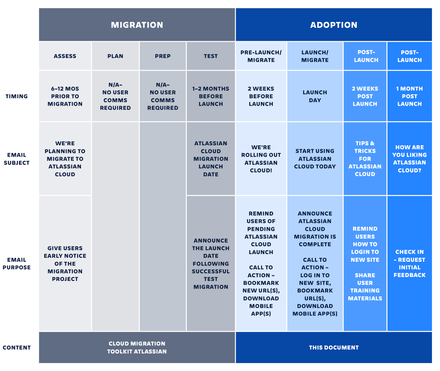Have more fun with Kudos
- Collect badges and make progress
- Participate in fun challenges
- Climb up the leaderboard
- Gift Kudos to your peers
Community resources
Community resources
Community resources
⚡️ Supercharge your cloud transformation efforts with these 🔟 Change management tips
Let’s face it, the decision to migrate to the cloud can be daunting, especially so for organizations that are experiencing broader shifts in ways of working. However (and I hope I’m preaching to the choir here), what if I told you that 🔮, rather than being a huge headache, migrating to the Atlassian Cloud ☁️ can be a huge asset in helping your organization adapt to the new normal? It’s clear that a cloud ☁️ transformation can have immense benefits beyond just tooling - including enhanced security and reliability, all while ensuring that knowledge workers remain productive.
That said, what’s been made evident repeatedly is that any technological endeavor will fail unless there is team buy-in. While it's common for some transformational efforts to recognize the people side of change when performing a migration, many of them do not.
The below👇🏽 tips can be used to ensure that organizations are considering the people side of change when migrating to the cloud.
Ultimately, this will help MAXIMIZE:
-
⬆️ Adoption
-
⬆️ ROI
-
⬆️ End-user engagement and productivity

1. 🕵🏼♀️ When it comes to a cloud migration, focus on the good, but also acknowledge the challenges
When going through a large shift in the way people work, there are bound to be teams that feel certain features or functionality are not what they’re accustomed to. So, it’s important to communicate the advantages, but don’t be afraid to acknowledge the challenges you’ll face as a team as well. Examples of challenges you may encounter could include the need for additional headcount to manage the migration, added expenses that come with a cloud migration, or the need for extensive data clean-ups. If the challenges are not openly and honestly acknowledged, teams may be even more resistant to change and resist further - this is an opportunity to build trust with transparency.
2. 👂🏼Understand and address any concerns or frustrations
It’s normal for teams to enter a project with expectations that do not necessarily align with reality. In the context of cloud transformations, what seems to count most in change management initiatives is how a change will impact people’s day-to-day. Therefore, grasping the source of that emotion and then communicating about it is critical. I can think of two ways to uncover fears that a team may have about a migration:
-
One, by inquiring. Instead of conducting a large poll, directly meet with individuals and teams. This will also allow for follow-up questions in order to fully capture why individuals and teams are concerned.
-
Two, interact with the critical thinkers. Every organization has individuals who examine potential changes from every angle, and are forthcoming about potential risks. These are the critical thinkers, and if one can convince them of the migration’s value proposition, then anyone can be convinced!
Additionally, utilizing informal mechanisms (think Slack, MS Teams, or with the help of your champions) for impacted teams to raise concerns and ask questions is a great way to stop frustrations from building up.
3. 🐢 Are we talking about a phased rollout, a big bang approach, or starting fresh?
With few exceptions, big bang rollouts require more preparation and coordination and fewer opportunities to learn and adjust along the way, which is why we see more organizations roll out gradually in phases. If the migration is phased, be sure to think large-scale and long-term, and ultimately consider the entire business during the rollout. Lastly, the option to start fresh should be considered given the benefit of avoiding migration efforts and the possibility of starting with a clean slate 🆕.
Regardless of which approach is chosen, it is helpful to keep the change formula in mind to ensure change effectiveness.

-
Who will be impacted? (People)
-
How will they be impacted? What will change? (Process)
-
What tools will be used? (Tools)
4. 🏆 Leverage your network of champions and appropriate executives
Developing a network of champions 🏅 will ensure one doesn’t need to rely solely on top-down communications to drive effective change. Instead, arm champions with the necessary knowledge and information around the migration so that they’re able to disseminate meaningful messaging as needed.
In parallel, having executive sponsorship🎗for the migration will help immensely. It is common to have worked on a project where progress has stalled. Decisions are made, reversed, and work cycles lost. Executive Sponsors change, stalling both initiatives and IT application deployments. The resources necessary to move forward are not made available. Timelines slip and the people involved become confused or alienated.
All of these issues are symptoms of a missing or inadequate Executive Sponsorship. The effectiveness of the Executive Sponsor (and their alignment down to the teams) is a top predictor of project success.
5. 🧪 Test end-user communications and messaging
A standard (and extremely vital) part of any change plan is in communicating the 5 Ws. Being diligent here, and testing messaging out before sending it to a wider audience will prove extremely helpful in ensuring teams are effectively checking language, tone, and strategy. Section 2 of the Cloud Adoption toolkit includes communication templates to give you some examples and ideas of how to make this go smoothly.
Additionally, sending out a single email on what to expect will likely not work. Instead, utilizing different mediums (such as internal communication announcements, town hall events, etc.) to get the word out will be sure to maximize eyeballs 👀 and transformation success ✅.
6. 🔓 Watch out for user access gaps
The last thing one wants is to complete the migration successfully, only to have users unable to access the content they need for their job. Therefore, it’s vital to ensure respective groups and permissions have the appropriate access before go-live. For first-time migrations, ensure you have an owner who will need to review and approve group permissions after migrating.
Do note, that global settings and global site permissions are not migrated with the Atlassian migration assistant tool, so one will need to set those manually before or after migration. Brush up on how groups and permissions are migrated with the migration assistant.
7. ⏲ TIMING. IS. EVERYTHING.
Once teams have decided on the who, how and what, it’s time to decide on the when. Determining when to go live with the migration needs to be done strategically. If a go-live is scheduled during a time when there are a number of other organizational changes also taking place, then the rollout is guaranteed to have speed bumps. Instead, having a calendar 🗓 of events (see below) managed by a POC leading change efforts has proven beneficial in ensuring that all upcoming change events (whether IT-led or otherwise) are tracked and planned for.

8. 🏋️♀️ Get creative with training
When migrating to the Atlassian cloud ☁️ there are a number of changes that an end-user will experience. These include changes in the user interface, navigation, issues view, board view, and how one goes about managing projects (all of which are documented in the Cloud Adoption toolkit). Given this, it’s important to offer end-users training across multiple different mediums in order to maximize coverage. Some users will prefer self-paced training content while others may wish to attend live sessions via lunch and learns for example. Additionally, the distribution of cheat sheets, tips & tricks, and FAQs will go a long way for those users who prefer just-in-time enablement. For more details, check out the Atlassian University courses here!
9. 🙅🏽♂️ Post migration, avoid operating in two ways
To avoid the risk of fractional cloud adoption, it’s recommended one limit access to the on-premise instance after migration and/or ensure that on-premise content is marked as read-only (to avoid confusion). If there’s a population of users (within the migrated group) who are still utilizing the old on-premise instance after go-live, then one is likely to see fewer benefits from a cloud migration (not to mention lower adoption).
10. 📊 Track performance, diagnose gaps, and implement corrective action
If KPIs have been identified and defined during the preparation stages, those metrics can be analyzed once the cloud migration is complete and systems are live. Based on end-user feedback and adoption metrics, teams should identify gaps in adoption and determine the cause.
-
If there are gaps identified around awareness of the change, then communication teams should consider adjusting 🛠 their messaging.
-
If teams/users are disengaged and/or disinterested in the change, then it might make sense to modify 🛠 the incentives in place and continue driving home the practical end-user benefits of adoption.
-
If teams/users are unsure how the change will impact them, then training materials may need to be modified 🛠 and redistributed.
Have you considered any of the tips above? Are there additional change management focus areas that one should focus on when going through a cloud transformation?
I’d love to hear about other cloud migration-related change management ideas in the comments if you have them!
Was this helpful?
Thanks!
Rish Singh

About this author
Sr. Technical Account Manager (TAM)
Atlassian
Atlassian Community Events
- FAQ
- Community Guidelines
- About
- Privacy policy
- Notice at Collection
- Terms of use
- © 2025 Atlassian





1 comment